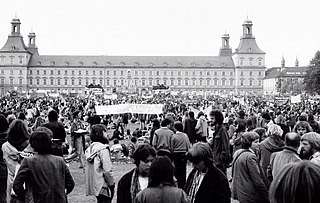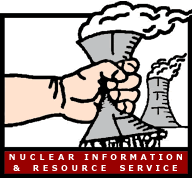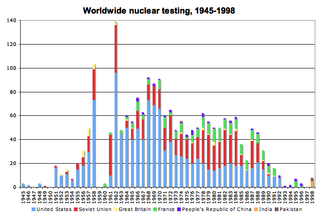History
Women Strike for Peace was founded by Bella Abzug and Dagmar Wilson in 1961. [4] The group initially was part of the movement for a ban on nuclear testing [5] and to end the Vietnam War, first demanding a negotiated settlement, and later total United States withdrawal from Southeast Asia. Their tactics included different forms of legal pressure such as petitions, demonstrations, letter writing, mass lobbies, and lawsuits. The group lobbied individual Congressmen with proxy requests from the Congressman's constituents. They also had a few forms of illegal, nonviolent direct action activities that included sit-ins in congressional offices, and statements of complicity with draft resisters aimed at tying up the courts. [6]
Actions
On November 1, 1961, at the height of the Cold War, about 50,000 women brought together by Women Strike for Peace marched in 60 cities in the United States to demonstrate against nuclear weapons under the slogan "End the Arms Race not the Human Race". [7] It was the largest national women's peace protest of the 20th century. [1] About 1,500 women led by Dagmar Wilson gathered at the foot of the Washington Monument while President John F. Kennedy watched from a window at the White House. The protest helped "push the United States and the Soviet Union into signing a nuclear test-ban treaty two years later". [1] In January 1962, Berkeley Women for Peace had a thousand women attend the California legislative session to oppose civil defense legislation. [6] Affiliate Seattle Women Act for Peace (SWAP) played a significant role in the protests against the Trident submarine base at Bangor, Washington. [1] The women were moved to action by the Soviet resumption of atmospheric nuclear tests, after a three-year moratorium and by the United States' declaration that it would hold its own tests in retaliation.
March on Washington build-up
The Women’s Strike for Peace organization wasn’t a unified one, and they had no known leaders and were completely unknown in the American political scene before the capitol strike on November 1st. [8] The women of WSP were responding to several women in Washington D.C. who were unnerved by how much the nuclear arms race was speeding up. [8] The women sent messages from Washington through word of mouth, and telephone calls to friends and contacts from church, already established peace organizations such as the Women’s International League for Peace and Freedom (WILPF) across America to cease their normal daily activities and join them from their own homes in a one day strike to end the arms race. [8] Each strike in each city depended solely on what the women were willing and able to do with different laws and regulations across states. [8]
Notable members
The group consisted mainly of married-with-children middle-class white women. [1] Its early tactics—including marches and street demonstrations were uncommon in the U.S. at that time—in many ways prefigured those of the anti-Vietnam War movement and of Second-wave feminism. The roots of the organization lay in the traditional female culture, the role women played as full-time wives and mothers and its rhetoric in those years drew heavily on traditional images of motherhood. [6] In particular, in protesting atmospheric nuclear testing, they emphasized that Strontium-90 from nuclear fallout was being found in mother's milk and commercially sold cow's milk, presenting their opposition to testing as a motherhood issue, [4] what Katha Pollitt has called "a maternity-based logic for organizing against nuclear testing." [4] As middle-class mothers, they were less vulnerable to the redbaiting that had held in check much radical activity in the United States since the McCarthy Era. [4] The image projected by WSP of respectable middle-class, middle-aged ladies wearing white gloves and flowered hats while picketing the White House and appealing to the Kremlin to save their children and the planet, helped to legitimize a radical critique of the Cold War and U.S militarism. [6]
In 1962, the members of the advance party of Women Strike for Peace met with Gertrude Baer, who at the time was the secretary for the Women's International League for Peace and Freedom (WILPF) in Geneva at the Seventeen-Nation Disarmament Conference. With their sights set on anti-militarism, they allied themselves with four other peaceful women's organizations: WILPF, Women's Peace Society (WPS, which was founded in 1919 by Fanny Garrison Villard, daughter of the nineteenth-century abolitionist William Lloyd Garrison), the Women's Peace Union (WPU), and the National Committee of the Causes and Cure of War (NCCCW). [9]
House Un-American Activities Committee (HUAC)
Women Strike for Peace played a crucial role in bringing down the House Un-American Activities Committee (HUAC). [9] From the beginning of the Women Strikes for Peace in 1961, the FBI had the group under surveillance due to fear that communism had spread to the mothers of America. [10] Women Strikes for Peace approached the committee hearings differently than those summoned before them. In November 1962 the leaders of the group were subpoenaed by the HUAC. After the subpoenas were distributed to the women, Women Strikes for Peace released the information to the media before the HUAC could issue a press release, as the committee usually used the news media to discredit the organizations subpoena. [6] When under question the women used their status as mothers to argue their moral high ground, as mothers arguing for peace were the most loyal Americans. [3] Another strategy that differed from those before them was the use of a large quantity of WSP members to volunteer to testify at the hearings, effectively showing that the group had nothing to hide. [8] Political theorist Jean Bethke Elshtain determined that the Women Strikes for Peace's performance at the HUAC was a success due to the "deconstructive power of a politics of humor, irony, evasion, and ridicule". [3] The use of motherhood and family as a tool for the attack on the congressional hearings showed the "familial-cold war consensus" would soon crumble. [10]
Nevada testing sites and their effects
The Nevada Proving Ground came to be where the United States perfected their nuclear weaponry. [11] The spot located a mere 65 miles north of Las Vegas replaced the Pacific Islands as a testing ground for these weapons. [11] Coined as an “outdoor laboratory” and an “experimental landscape”, several government sponsored activities took place there. [11] “Doom Towns” were constructed with mannequin families to test these weapons on. [11]
The WSP protested in part because of the effects of the particles and debris that remained in the air after years of nuclear testing. [12] The radioactive effects after World War II were said to be the first global environmental issue in both scale and potency of the “post-war era”, said by historian John McCormack. [12] With more than 120 official weapon tests in the Pacific and Nevada, depositing immense amounts of radioactive debris which caused levels of ionizing radiation to slowly increase over time. [12] The nuclear arms race made the world more radioactive. [12] The debris spread onto things like food and drinks and in the very air we breathed, causing cancer and birth defects. [12] People were ignorant of the possible health risks and would have picnics at high points near the testing site to watch government experiments. [12] Exposure to radiation and the effects it had on civilians and the unborn were a driving force for the Women’s Peace Movement to strike to end the nuclear race and stop this rising environmental issue as it was harming the innocent. [13]
Baby Tooth Survey
The Greater St. Louis Citizens’ Committee for Nuclear Information initiated the Baby Tooth Survey. This was a plan to collect 50,000 baby teeth per year, in order to test them and provide a record of how much strontium-90 children in the surrounding areas were taking in. [14] The concentration of strontium-90 is considered the most hazardous form of atomic debris. [15] Participants were asked to mail in the baby teeth of their children in order to participate. Parents were so concerned by the extensive nuclear testing in the atmosphere and the resulting radioactive product that they were very likely to participate in the survey and send in their children’s teeth. One piece of evidence that raised concern was that the milk from around the area had some of the highest results when it came to containing strontium-90. [14] “Pure Milk Not Poison” became a common slogan and concerns about the milk led to boycotts and use of powdered milk as a substitute. [16] The results of the survey were clear when it was shown that when testing teeth from children that had been bottle fed, the strontium-90 content increased from 1949 to 1953, but then increased very rapidly between 1954 and 1955, which coincided with the major nuclear testing that began in 1953. [17]
Post-1960s
In Los Angeles, in 1965 and 1970, the Women Strike for Peace Movement, headed by Mary Clarke, published a cookbook that Clarke inspired. The cookbooks, Peace de Resistance, were printed by the noted Ward Ritchie at the Anderson, Ritchie & Simon Press. Author Esther Lewin had lived in France for a period of time and was well-versed in French cooking. Lewin included simple recipes for those days when WSP required their efforts and more complicated recipes for the more relaxed days. [18] [19]
WSP remained a significant voice in the peace movement throughout the 1980s and 1990s, speaking out against U.S. intervention in Latin America and the Persian Gulf states. On June 12, 1982, Women Strike for Peace helped organize one million people who demanded an end to the arms race. In 1988, they supported Carolyna Marks in the creation of the Unique Berkeley Peace Wall, as well as similar walls in Oakland, Moscow, Hiroshima, and Israel (a joint Jewish and Palestinian children's Peace Wall). In 1991, they protested the Iraq-Persian Gulf War; afterwards, they urged the American government to lift sanctions on Iraq. In the late 1990s, Women Strike for Peace mainly focused on nuclear disarmament. [6]

Nuclear disarmament is the act of reducing or eliminating nuclear weapons. Its end state can also be a nuclear-weapons-free world, in which nuclear weapons are completely eliminated. The term denuclearization is also used to describe the process leading to complete nuclear disarmament.

Building on major scientific breakthroughs made during the 1930s, the United Kingdom began the world's first nuclear weapons research project, codenamed Tube Alloys, in 1941, during World War II. The United States, in collaboration with the United Kingdom, initiated the Manhattan Project the following year to build a weapon using nuclear fission. The project also involved Canada. In August 1945, the atomic bombings of Hiroshima and Nagasaki were conducted by the United States, with British consent, against Japan at the close of that war, standing to date as the only use of nuclear weapons in hostilities.

Opposition to United States involvement in the Vietnam War began with demonstrations in 1965 against the escalating role of the United States in the Vietnam War. These demonstrations grew into a broad social movement over the ensuing several years. This movement informed and helped shape the vigorous and polarizing debate, primarily in the United States, during the second half of the 1960s and early 1970s on how to end the Vietnam War.

The Women's International League for Peace and Freedom (WILPF) is a non-profit non-governmental organization working "to bring together women of different political views and philosophical and religious backgrounds determined to study and make known the causes of war and work for a permanent peace" and to unite women worldwide who oppose oppression and exploitation. WILPF has national sections in 37 countries.

The anti-nuclear movement is a social movement that opposes various nuclear technologies. Some direct action groups, environmental movements, and professional organisations have identified themselves with the movement at the local, national, or international level. Major anti-nuclear groups include Campaign for Nuclear Disarmament, Friends of the Earth, Greenpeace, International Physicians for the Prevention of Nuclear War, Peace Action, Seneca Women's Encampment for a Future of Peace and Justice and the Nuclear Information and Resource Service. The initial objective of the movement was nuclear disarmament, though since the late 1960s opposition has included the use of nuclear power. Many anti-nuclear groups oppose both nuclear power and nuclear weapons. The formation of green parties in the 1970s and 1980s was often a direct result of anti-nuclear politics.

The anti-nuclear movement in the United States consists of more than 80 anti-nuclear groups that oppose nuclear power, nuclear weapons, and/or uranium mining. These have included the Abalone Alliance, Clamshell Alliance, Committee for Nuclear Responsibility, Nevada Desert Experience, Nuclear Information and Resource Service, Physicians for Social Responsibility, Plowshares Movement, United Steelworkers of America (USWA) District 31, Women Strike for Peace, Nukewatch, and Women's International League for Peace and Freedom. Some fringe aspects of the anti-nuclear movement have delayed construction or halted commitments to build some new nuclear plants, and have pressured the Nuclear Regulatory Commission to enforce and strengthen the safety regulations for nuclear power plants. Most groups in the movement focus on nuclear weapons.
Anti-nuclear organizations may oppose uranium mining, nuclear power, and/or nuclear weapons. Anti-nuclear groups have undertaken public protests and acts of civil disobedience which have included occupations of nuclear plant sites. Some of the most influential groups in the anti-nuclear movement have had members who were elite scientists, including several Nobel Laureates and many nuclear physicists.

A peace movement is a social movement which seeks to achieve ideals such as the ending of a particular war or minimizing inter-human violence in a particular place or situation. They are often linked to the goal of achieving world peace. Some of the methods used to achieve these goals include advocacy of pacifism, nonviolent resistance, diplomacy, boycotts, peace camps, ethical consumerism, supporting anti-war political candidates, supporting legislation to remove profits from government contracts to the military–industrial complex, banning guns, creating tools for open government and transparency, direct democracy, supporting whistleblowers who expose war crimes or conspiracies to create wars, demonstrations, and political lobbying. The political cooperative is an example of an organization which seeks to merge all peace-movement and green organizations; they may have diverse goals, but have the common ideal of peace and humane sustainability. A concern of some peace activists is the challenge of attaining peace when those against peace often use violence as their means of communication and empowerment.

More than 80 anti-nuclear groups are operating, or have operated, in the United States. These include Abalone Alliance, Clamshell Alliance, Greenpeace USA, Institute for Energy and Environmental Research, Musicians United for Safe Energy, Nevada Desert Experience, Nuclear Control Institute, Nuclear Information and Resource Service, Public Citizen Energy Program, Shad Alliance, and the Sierra Club. These are direct action, environmental, health, and public interest organizations who oppose nuclear weapons and/or nuclear power. In 1992, the chairman of the Nuclear Regulatory Commission said that "his agency had been pushed in the right direction on safety issues because of the pleas and protests of nuclear watchdog groups".
Women's Peace Union (WPU) was a radical pacifist organization founded in 1921 as a joint effort of women from the United States and Canada with the goal of outlawing war. Its single purpose was to push through a Constitutional Amendment to prohibit war.

Anti-nuclear protests began on a small scale in the U.S. as early as 1946 in response to Operation Crossroads. Large scale anti-nuclear protests first emerged in the mid-1950s in Japan in the wake of the March 1954 Lucky Dragon Incident. August 1955 saw the first meeting of the World Conference against Atomic and Hydrogen Bombs, which had around 3,000 participants from Japan and other nations. Protests began in Britain in the late 1950s and early 1960s. In the United Kingdom, the first Aldermaston March, organised by the Campaign for Nuclear Disarmament, took place in 1958. In 1961, at the height of the Cold War, about 50,000 women brought together by Women Strike for Peace marched in 60 cities in the United States to demonstrate against nuclear weapons. In 1964, Peace Marches in several Australian capital cities featured "Ban the Bomb" placards.

The application of nuclear technology, both as a source of energy and as an instrument of war, has been controversial.

Dagmar Searchinger Wilson was an American anti-nuclear testing activist, artist, and illustrator of children's books for Whitman's Children's Books.

Gary Eugene Rader was an American Army Reservist known for burning his draft card in protest of the Vietnam War, while wearing his U.S. Army Special Forces uniform. Afterward, he engaged in anti-war activism.
Canadian Voice of Women for Peace, also known as the Voice of Women or VOW, is a Canadian anti-nuclear pacifist organization that was formed in 1960. The organization was created in response to an article in which Lotta Dempsey, a journalist for the Toronto Star, called out for action against the threat of nuclear war and asked women to work together for peace. After the article was published, a group of women contacted Dempsey and formed a women's organization called the Canadian Voice of Women for Peace. The organization's work has spanned multiple decades and is Canada's oldest feminist peace group.

Nuclear ethics is a cross-disciplinary field of academic and policy-relevant study in which the problems associated with nuclear warfare, nuclear deterrence, nuclear arms control, nuclear disarmament, or nuclear energy are examined through one or more ethical or moral theories or frameworks. In contemporary security studies, the problems of nuclear warfare, deterrence, proliferation, and so forth are often understood strictly in political, strategic, or military terms. In the study of international organizations and law, however, these problems are also understood in legal terms. Nuclear ethics assumes that the very real possibilities of human extinction, mass human destruction, or mass environmental damage which could result from nuclear warfare are deep ethical or moral problems. Specifically, it assumes that the outcomes of human extinction, mass human destruction, or environmental damage count as moral evils. Another area of inquiry concerns future generations and the burden that nuclear waste and pollution imposes on them. Some scholars have concluded that it is therefore morally wrong to act in ways that produce these outcomes, which means it is morally wrong to engage in nuclear warfare.
The Vancouver Indochinese Women's Conference (VICWC) took place in April 1971, where close to a thousand women from Canada and the United States met with Indochinese women in Vancouver, British Columbia, Canada in a protest of the Vietnam War organized by the Voice of Women. There was also a sister conference in Toronto, held from April 9 to 11, 1971. These women came from various backgrounds and cultures; black Chicana/Latina, white, and Indochinese women all participated. This conference was a spinoff from an earlier and smaller Indochinese feminist conference which was held in 1967 to give voice to marginalized women.
Frances W. Herring was a Professor of Government at University of California, Berkeley. She was the leader of the Women Strike for Peace in 1961 and a signatory on The Triple Revolution.
Napalm ladies was the name attributed to the four American women activists noted for blocking shipments of napalm bombs bound for Vietnam during the Vietnam War. The peace activists were Joyce McLean, Beverly Farquhar, Lisa Kalvelage, and Aileen Hutchinson.
Ruth Gage-Colby was an American lecturer, journalist, pacifist, and activist. A well-known figure in the 20th-century peace movement, Gage-Colby occupied leadership positions in the Women's International League for Peace and Freedom, and Women Strike for Peace.













